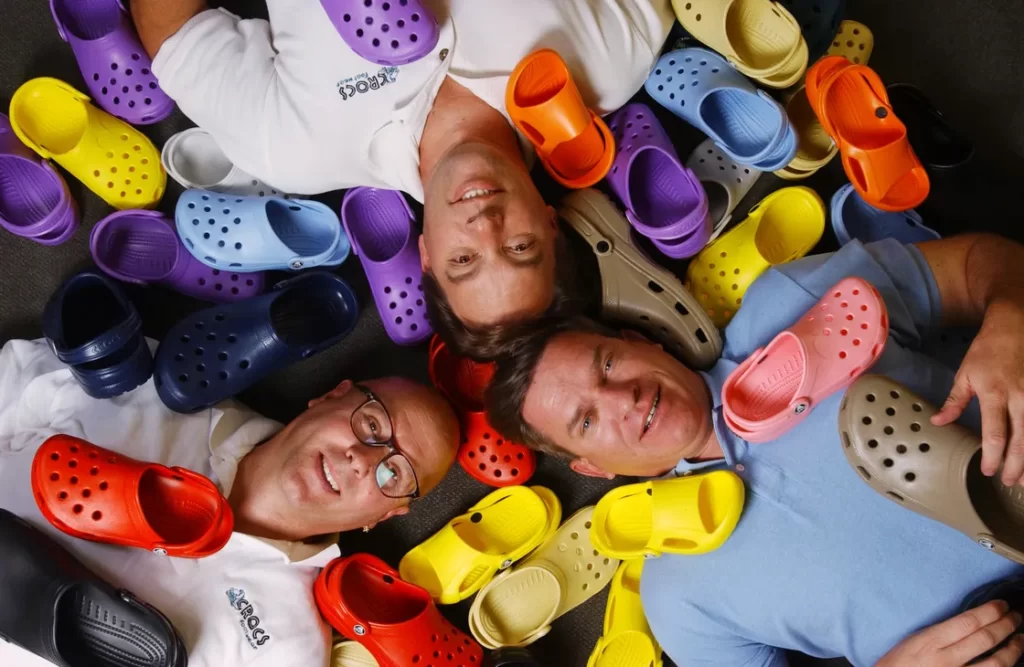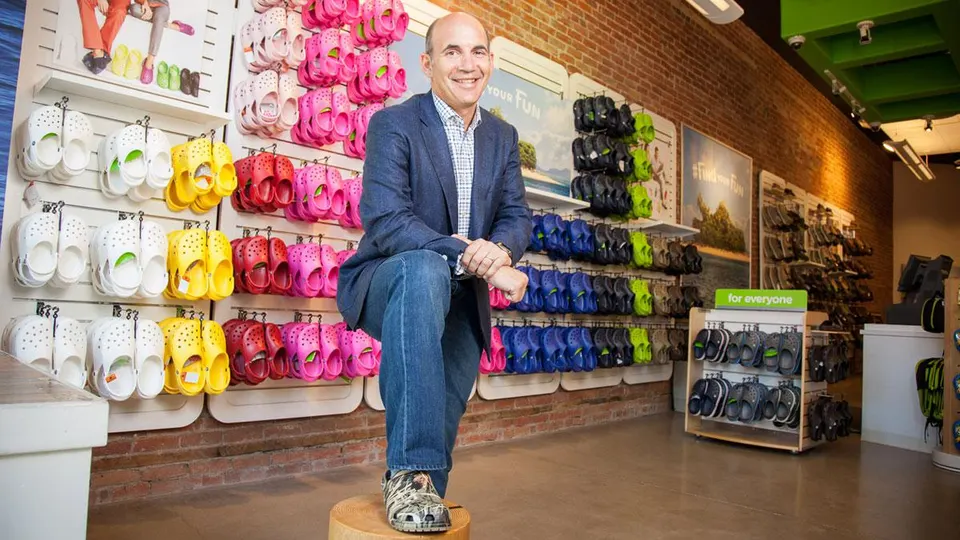When the Crocs co-founder first laid eyes on a prototype of the shoes back in 2002, his initial reaction was a simple, “Those are ugly.” However, these so-called “ugly” shoes defied expectations and went on to create a multi-billion dollar publicly traded company. They gained popularity among celebrities and even graced the runways of Paris Fashion Week. How did three founders with no prior experience in footwear manage to build such a wildly successful shoe company? Let’s delve into the untold truth behind the astonishing rise of Crocs.
From Setbacks to a Sailing Trip: A Turning Point
In 2002, Lyndon Hanson found himself at a low point in life. Following his separation from his wife, he was left sleeping on a friend’s couch. Simultaneously, he faced the loss of his job in computer hardware marketing, and the devastating passing of his mother due to cancer. It seemed like troubles were raining down on him endlessly. Recognizing his friend’s despair, George Bodecker and Scott Siemens, long-time acquaintances of Lyndon, decided to lift his spirits. They organized a sailing trip in the Caribbean, hoping it would provide solace and clarity for Lyndon.
Scott, an accomplished inventor who had made a comfortable living through product development and patenting, had been working on a pair of rubber-like clogs. His inspiration struck during a business trip to Canada when he stumbled upon a similar product. As the friends set sail together, Scott proposed that Lyndon and George try on the clogs he had been working on.
The Birth of an Ugly but Unique Shoe
The early version of these shoes was developed by a Quebec-based manufacturing company called Foam Creations Incorporated. Surprisingly, the material used wasn’t rubber or plastic but a special resin that exhibited several remarkable properties. These shoes were resistant to odor and water, had excellent slip resistance on boat decks, and molded comfortably to the shape of the foot. The only flaw Scott identified was the absence of a backstrap, prompting him to add one himself. With the vision of securing investors and distributing this improved version of clogs in the United States, Scott eagerly introduced his invention to his two friends.

Initially, George and Lyndon were skeptical, finding the shoes unattractive. However, after spending some time actually wearing them, they discovered that the shoes were remarkably lightweight and comfortable. Their perception underwent a complete transformation, and they decided to embark on a business venture together.
Drawing inspiration from the versatility of crocodiles, creatures that thrive in both land and water, the trio named their new company “Crocs.” George, an accomplished individual in his own right, had a challenging childhood but managed to establish his own lawn mowing business at the tender age of 10. He went on to become a star student athlete, securing a college scholarship. Later in life, George owned over 100 Domino’s Pizza franchises and held an executive position at the renowned sandwich chain, Quiznos. With their combined business experience, the three friends possessed a reasonable foundation for their new venture. However, they faced one significant obstacle: their lack of knowledge about the shoe market.
Building a Foundation for Success
When Crocs was just starting out, the founders faced the challenge of establishing a distribution model to introduce their unconventional footwear to the American market. Lyndon, one of the co-founders, spearheaded the development of a comprehensive plan, while Scott focused on refining the product itself. With George’s substantial investment, they set up their base in Boulder, Colorado, and placed their initial order with the supplier. However, they knew that selling the shoes would be the ultimate test.
Recognizing the practicality of Crocs on boat decks, the founders decided to showcase their product at a Florida boat show in 2002. They anticipated that the novelty and uniqueness of the shoes would intrigue potential buyers. Their bold tactic involved throwing the shoes at passersby and encouraging them to try them on, even if they found them visually unappealing. Surprisingly, this unconventional approach yielded tremendous success, resulting in approximately 200 pairs of Crocs being sold during the boat show.
Expanding Beyond the Boat
While the founders initially targeted boat enthusiasts, they soon discovered that Crocs had immense potential beyond the boating community. Workers from various industries, including healthcare, hospitality, and culinary sectors, found the shoes perfect for their demanding work environments. This unforeseen demand revealed a consumer niche waiting to be tapped, indicating the vast possibilities that lay ahead for Crocs.
Despite skeptics dismissing Crocs as a fleeting fashion trend, the company continued its upward trajectory. Crocs sold an impressive 76,000 pairs in 2003, and between 2005 and 2006, their revenue surged by a remarkable 226 percent. The founders’ astute business decisions played a pivotal role in this growth. They acquired Foam Creations Incorporated, securing exclusive rights to the innovative Croslite foam material used in manufacturing Crocs. Additionally, they implemented a unique distribution and restocking system, which minimized risks for retailers and ensured wider availability of their shoes across various store sizes.
Read More – JP Morgan: The Hero Who Rescued America Twice
Fueling Publicity and Demand
Crocs’ distinct design sparked strong opinions, leading to widespread discussions and debates. While not everyone embraced the unconventional aesthetics, the brand’s unique appearance ensured it stood out and sparked conversations. This controversy inadvertently generated significant publicity for Crocs, ultimately fueling consumer interest and driving up demand.
In 2006, Crocs reached a major milestone by going public with its initial public offering (IPO), raising a staggering $239 million. This marked the highest IPO ever for a footwear company and catapulted Crocs’ market value to over a billion dollars. The combination of publicity, growing demand, and financial success solidified Crocs’ position as an industry disruptor and showcased its potential for long-term success.
Maintaining a breakneck pace of expansion came with its own set of challenges. As Crocs experienced rapid growth, the founders and early investors faced the demanding task of meeting escalating demands while preserving the brand’s integrity. The intense workload took a toll on all the founders, highlighting the sacrifices they made to drive the business forward. Despite the challenges, their unwavering dedication and resilience ensured Crocs remained at the forefront of the industry.
A Troubling Incident Unveiled
George Bodecker’s journey took an unexpected turn shortly after Crocs went public. Reports emerged of a chilling phone call he made to his brother-in-law, where he allegedly made grave threats, saying, “I’m gonna bury you so deep that no one will ever find you. I’m going to slit your throat.” Such a disturbing statement raises questions about George’s state of mind during this period.

George’s hostility seemed to extend beyond mere threats. Approximately 20 minutes after the phone call, he confronted his brother-in-law at his office, ready for a physical altercation. While the exact reason for this conflict remains unclear, various accounts indicate that George’s behavior had become increasingly erratic both inside and outside the workplace.
Despite the negative light cast upon George Bodecker, it is crucial to acknowledge his immense contribution to Crocs’ early success. His passion and managerial skills played a pivotal role in the company’s formation. However, as time went on, his actions and demeanor caused his reputation to suffer significantly. Former employees attest to the fact that mentioning George Bodecker’s name at the Crocs office became taboo, reflecting the stain he had left on the company.
In response to George’s controversial incidents, Crocs swiftly distanced themselves from their co-founder. In 2012, he faced legal trouble when police accused him of driving under the influence. Rather than accepting responsibility, he falsely claimed that his girlfriend was the one behind the wheel—none other than pop star Taylor Swift. The public exposure of this incident brought negative publicity to Crocs, causing further strain on the brand’s image.
Following George’s resignation as CEO, Ron Snyder, a close friend of the other co-founder, took the helm at Crocs. Snyder’s support during Lyndon’s challenging times had earned him the trust to lead the company forward. Under his guidance, Crocs experienced a transformative period of success.

With Ron Snyder as CEO, Crocs underwent exponential growth and diversification. The company expanded its product line from a mere two shoe models to an impressive collection of around 250. This expansion contributed to an increase in revenue and boosted stock values. Moreover, Crocs actively pursued international markets, establishing a formidable global presence.
Strategic Acquisitions and Licensing
Crocs’ success was not solely reliant on footwear innovation. The company strategically acquired adjacent companies such as Jibbitz, a brand specializing in shoe charms. This move allowed Crocs customers to personalize their footwear, creating a unique and customizable experience. Additionally, licensing agreements with renowned entities like Disney and the NBA further elevated Crocs’ brand visibility and appeal.
The Financial Crisis and Legal Challenges
In 2007, Crocs encountered significant setbacks due to the financial crisis of 2008. As consumer spending plummeted, sales and stock prices followed suit, forcing the company to confront declining revenue. Consequently, Crocs resorted to multiple rounds of layoffs and encountered severe struggles in the stock market.
Amidst this turmoil, Select LLC raised allegations in 2008, claiming that Crocs had infringed on a 1999 patent for a material strikingly similar to their own innovative Croslite. Moreover, manufacturers producing Crocs imitations contended that the brand was itself a copy of an Italian shoe design predating Crocs. These allegations further eroded Crocs’ stock price, exacerbating their financial challenges.
A Remarkable Turnaround
Despite the setbacks, Crocs’ fortunes began to change in the following years. The revival can be attributed to a combination of shrewd marketing tactics and celebrity endorsements. Several influential figures, including actor Shia LaBeouf, were photographed donning Crocs, which helped reshape the public perception of the brand.

Interestingly, Crocs recognized the power of polarization. Rather than striving for a universally appealing design, the company embraced their distinctive aesthetic. People either loved or loathed Crocs, and this dichotomy became a unique selling point. Crocs embraced the concept of acceptance, individuality, and creativity, positioning themselves as a brand that encouraged self-expression without concern for others’ opinions.
Leveraging this newfound direction, Crocs embarked on a series of strategic partnerships with notable celebrities such as Justin Bieber and Post Malone. Surprisingly, even collaborations with unconventional brands like Kentucky Fried Chicken, featuring scented fried chicken chew charms, garnered immense attention. This approach allowed Crocs to adapt to diverse collaborations, ranging from high-fashion collaborations with Barneys and Balenciaga to the avant-garde and unexpected.
The Triumph Amidst the Pandemic
Crocs’ pursuit of collaborations proved highly deliberate, aiming to generate substantial media coverage through surprising partnerships. The brand’s ability to captivate attention by collaborating with Cheerio cereal or gracing high-end fashion models created a continuous stream of publicity.
Remarkably, the COVID-19 pandemic unexpectedly became a turning point for Crocs. While numerous apparel companies faced adversity, Crocs experienced unprecedented success. As comfort triumphed over style, Crocs’ sales skyrocketed to unprecedented heights. The brand’s emphasis on online sales, including prioritized sizing and the closure of costly retail stores, positioned them to capitalize on the e-commerce boom. In 2020, Crocs achieved its best year ever, with sales surging and stock values soaring by an impressive 300%. This trend continued into 2021, as Crocs reported record-high revenue of $2.3 billion.
The Quest for Timeless Relevance
As a footwear brand, Crocs faces the perennial challenge of remaining relevant in an ever-changing fashion landscape. The transient nature of trends questions whether Crocs will endure as a lasting staple of global culture. Nevertheless, with a rich 20-year history and global recognition, Crocs has defied expectations. Their current financial success and ability to convert an initially reviled design into a fashion icon is a testament to the brand’s resilience.











